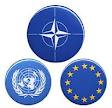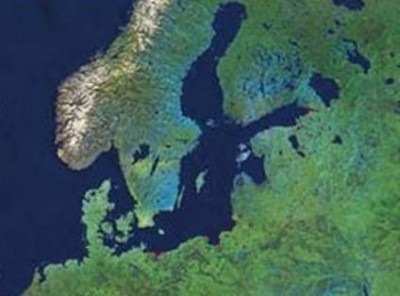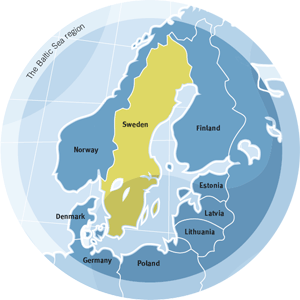Sins of Omissions: The United Nations Ignores Terrorism Within Syrian Rebel Organizations
On October 23, 2012, Syrian Ambassador to the United Nations
Bashar Ja’afari sent a letter to the President of the United Nations
Security Council and to U.N. Secretary-General Ban Ki-moon listing 108
foreign individuals arrested in the Syrian Arab Republic . All
individuals were engaged in terrorist activities within Syria . Many of
these terrorists were members of Al Qaeda in Iraq , others were
jihadists from Lebanon, Jordan, Tunisia, Libya, Palestine, Egypt and
Australia.
In an interview I had with Ambassador Ja’afari, he confirmed that
this letter was also circulated to all United Nations committees
concerned with counter-terrorism. The letter was not translated from
the Arabic for several months. Although the relevant United Nations
organs were established to address precisely the crisis of the
international spread of terrorism, absolutely no action was taken by any
of these United Nations committees to halt or even address this massive
invasion into Syria by foreign terrorists who joined the Syrian
“rebels.”
United Nations Resolution 1963, Adopted by the Security Council on 20 December, 2010 states:
“Reaffirming that terrorism in all its forms and
manifestations constitutes one of the most serious threats to
international peace and security and that any acts of terrorism are
criminal and unjustifiable regardless of their motivations, whenever and
by whomsoever committed, and remaining determined to contribute further
to enhancing the effectiveness of the overall effort to fight this
scourge on a global level.”
On November 21, 2012, Syrian Ambassador Bashar Ja’afari presented a
second letter to the President of the UN Security Council, and to UN
Secretary-General Ban Ki-moon, containing another list of 143 “Foreign
and Arab individuals who were killed in Syria while carrying out their
terrorist activities. The list includes information about each
individual: name, age, date and place of death, and nationality. The
majority of the individuals entered the Syrian Arab Republic illegally,
and they hold passports of different nationalities such as: Qatari,
Saudi, Tunisians, Egyptian, Sudanese, Libyans, Afghani, Jordanians,
Turks, Yamani, Iraqi, Azerbaijani, Chechnya , Kuwaitis, Palestinians,
Lebanese, Algerians, Chadian and Pakistani.”
Ambassador Ja’afari confirmed, in our interview that, again, the
translation of the letter from the Arabic was delayed, inexplicably. He
confirmed that this second letter was again circulated to all United
Nations committees dealing with counter-terrorism. Again, absolutely no
action was taken by these committees whose responsibility it is to halt
the massive spread of terrorists such as are now invading Syria to join
the Syrian “opposition.” Absolutely no action was taken by the UN
Security Council to halt this influx of foreign terrorists into Syria ,
or even to address these letters, despite the fact that many of these
jihadists were members of Al Qaeda.
Evidently, all terrorism in unjustifiable, but some terrorism is
justifiable. This incriminating double standard is revealed in two
resolutions adopted by the Security Council almost simultaneously with
the Syrian Ambassador’s letters, which continue to be ignored.
Resolution 2078, adopted on November 28, 2012, on the Democratic
Republic of the Congo states: “Expresses deep concern at reports
indicating that external support continues to be provided to the M23,
including through troop reinforcement, tactical advice and the supply of
equipment, causing a significant increase of the military abilities of
the M23, and reiterates its demand that any and all outside support to
the M23 cease immediately.”
On December 20, 2012, Security Council Resolution 2085, under Chapter
VII of the United Nations Charter was unanimously adopted, stating:
“Demands that Malian rebel groups cut off all ties to terrorist
organizations, notably Al-Qaeda in the Islamic Maghreb (AQIM) and
associated groups, and take concrete and visible steps to this effect,
takes note of the listing of Movement of Unity and Jihad in Western
Africa (MUJWA) on the Al-Qaeda sanctions list established and maintained
by the Committee pursuant to Resolutions 1267 (1999) and 1989 (2011)
and further reiterates its readiness to continue to adopt further
targeted sanctions, under the above-mentioned regime, against those
rebel groups and individuals who do not cut off all ties to Al-Qaeda and
associated groups, including AQIM and MUJWA.”
The United Nations failure to condemn the vast numbers of terrorists,
particularly those affiliated with Al-Queda, infesting the Syrian
“opposition” makes a mockery of the Counter-Terrorism apparatus, whose
actions are too often politicized and applied “selectively,” confirming
the observation that “All acts of terrorism are criminal and
unjustifiable, but some acts of terrorism are welcome if they contribute
to regime change in Syria (or in other independent states).”
On January 7, President al-Assad of Syria declared:
“We didn’t choose war, war was imposed on Syria…We are
fighting those, most of whom are non-Syrians, who came for twisted
concepts and fake terms they call jihad….and I believe that most of you
know how this kind of terrorism was fostered three decades ago in
Afghanistan by the West and with Arabs’ money. After the mission of
these terrorists ended with the disintegration of the Soviet Union,
terrorism broke loose and started hitting everywhere in the Arab world,
the Islamic world and then moved to the West…Syria has always been and
will remain a free and sovereign country that won’t accept submission
and tutelage.
That is why it has been a nuisance for the West….As for the West, the
descendant of colonialism and owner of the first seal in the policy of
division and despicable sectarian strife, it is the one who closed the
door of dialogue, not us. It’s used to giving orders to the submissive,
and we’re used to sovereignty, independence and freedom of decision…
because the West is addicted to hirelings and the subjugated, and
because we’re raised on dignity and pride, and so we shall remain. …They
call it a revolution, but in fact it has nothing to do with revolution.
A revolution needs thinkers. A revolution is built on thought.
Where are their thinkers? A revolution needs leaders. Who is its
leader? Revolutions are built on science and thought and not on
ignorance, on pushing the country ahead, not taking it centuries back,
on spreading light not cutting power lines. A revolution is usually
done by the people, not by importing foreigners to rebel against the
people.
Are those revolutionaries? They are a bunch of criminals.”
On January 16, the New York Times reported former UN Envoy Kofi Annan
“warning that the opposition’s insistence that Mr. Assad step down
before any negotiations begin is perpetuating a stalemate and risking a
descent into chaos.” Former Syria advisor to the Obama administration,
Frederic C. Hof “wrote last month that although the opposition has
offered general assurances to the one-third of Syrians who belong to
minority groups, ‘probably no more than a handful believe it, especially
as jihadist groups grow more prominent on the battlefield and issue
videotaped calls for the restoration of the Islamic Caliphate.’”
This week Islamic terrorists kidnapped American, French, British,
Japanese and Norwegian citizens, together with many Algerians, working
at an internationally managed natural gas field in Algeria, killing
numerous people. According to The New York Times, “Energy experts
expressed concern that the Algerian raid could signal a new strategy by
Islamic militants to attack the West by focusing on Western-operated oil
and gas facilities in the region. Helima Croft, a Barclays Capital
senior geopolitical strategist said if groups like Al Qaeda in the
Islamic Maghreb ‘decide as a change in tactic they go after Western
energy interests, then you have to look at a threat in all these
countries.’”
The kidnapping this week in Algeria was masterminded by Mokhtar
Belmokhtar, who got his terrorist training in Afghanistan in the 1980s.
Perhaps the most compelling and illuminating of President Assad’s
remarks on January 7 is his reference to the fact that the terrorists
now destroying Syria, and proliferating throughout the Middle East,
Africa, parts of Asia and elsewhere, were created by the United States
(though he does not make specific reference to one Western country)
during the Carter administration, which funded, armed and trained
pathological killers inculcated with religious fanaticism, a policy
which unleashed, with criminal irresponsibility, an army of psychotics
for the purpose of destroying the Soviet Union and socialism, in order
to increase the exorbitant profits of capitalist oligarchs.
That heinous policy bequeathed to us a now uncontrollable scourge of
terrorists which are not only claiming the lives of thousands of Syrian
civilians and government officials, but as these barbarians inflict
their sharia law, which violates every civilized protection guaranteed
by the United Nations Universal Declaration of Human Rights, the world
is being driven back to the most primitive stage. Amputations of limbs,
floggings and flaying to death, blinding schoolgirls with acid, stoning
young girls to death is the trademark of these terrorists, reminiscent
of the darkest ages of the inquisition and medieval superstition
The only force now capable of containing this plague of religious
insanity serving as the tool of capitalism, is the Russian-Chinese
Shanghai Cooperation Organization and the Collective Security Treaty
Organization, cognizant of the fact that if the Assad government is
overthrown, chaos of unimaginable and devastating force will ensue.
Ironically, in his book “The Grand Chessboard,” Brzezinski, the
architect of the Carter administration policy which armed, trained and
funded these Islamic terrorists which have now metastasized, threatening
the very core of civilization itself, Carter’s national security
adviser cites, as his greatest dread, that very Russian-Chinese alliance
which is now the only hope of saving civilization and resisting another
world war.
________________________________________________________________________________________________________________________________________________
Annex
The letter presented by the Syrian Ambassador to the United Nations is reproduced below.
United Nations S/2012/867
Security Council Distr.: General
3 December 2012
Original: English
12-62458 (E) 061212 071212
*1262458*
Identical letters dated 21 November 2012 from the
Permanent Representative of the Syrian Arab Republic to the United
Nations addressed to the Secretary-General and the President of the
Security Council
Upon instructions from my Government, in the light of
the ongoing terrorist attacks that have been conducted by the armed
terrorist groups in the Syrian ArabRepublic, and following our previous
letters, I am transmitting herewith a list that contains the names of
143 foreign and Arab individuals who were killed in Syria while carrying
out their terrorist activities. The list includes information about
each individual’s name, age, date and place of death, and nationality.
The majority of the individuals entered the Syrian Arab
Republic illegally, and they hold different nationalities, such as
Qatari, Saudi Arabian, Tunisian, Egyptian, Sudanese, Libyan, Afghani,
Jordanian, Turkish, Yemeni, Iraqi, Azerbaijani, Chechen,
Kuwaiti,Palestinian, Lebanese, Algerian, Chadian and Pakistani (see
annex).
It would be greatly appreciated if the present letter and its annex could be issued as a document of the Security Council.
(Signed) Bashar Ja’afari
Ambassador
Permanent Representative
S/2012/867
2 12-62458
[Original: Arabic]
[Annexed to the letter]
[List of Arrested Mercenaries involved in Terrorist Acts]
No. Nationality Name and surname Incident Date
1 Palestinian Syrian Muhammad Sulayman Ibn Khidr Wasna Killed while attacking the Khanasir area
and its police station in Safirah, Aleppo
2 February 2012
2 Libyan Safwan Abdullah al-Affani (age 40) Killed with other terrorists in the Kafr
Karmin forest and interred in Anjarah,
Aleppo
7 August 2012
3 Afghan Abu Abdullah (age 37) Killed with other terrorists in Dar Ta‘izzah,
Aleppo
11 September 2012
4 Afghan Abu Ayyub al-Aridi (age 61) Killed with other terrorists in Dar Ta‘izzah,
Aleppo
11 September 2012
5 Tunisian Al-Marzuq Billah (age 41) Killed with other terrorists in Dar Ta‘izzah,
Aleppo
11 September 2012
6 Egyptian Also known as “Abu Imad” (Al-Qaida) Killed with other terrorists in Dar Ta‘izzah,
Aleppo
11 September 2012
7 Sudanese Abdurahman al-Ibrahim (Al-Qaida) Killed with other terrorists in Dar Ta‘izzah,
Aleppo
11 September 2012
8 Tunisian Nasir Abdullah Abu al-Walid (Al-Qaida) Killed while driving a stolen tank in front
of the artillery corps in Aleppo
11 September 2012
9 Libyan Abu Khalid (age 37, Al-Qaida) Killed in a stolen tank in front of the
artillery corps in Aleppo
11 September 2012
10 Afghan Abu Qatadah (age 45, sniper) Killed in Ibizimu as a result of clashes with
the Army
14 September 2012
11 Libyan Abu Khalil, aka “al-Mukhadram” (age 43) Killed with other terrorists as a result of
clashes with the Army in Atarib
16 September 2012
S/2012/867
12-62458 3
No. Nationality Name and surname Incident Date
12 Tunisian Also known as “Sheikh of the
Revolutionaries” (age 48) (Al-Qaida)
Killed with other terrorists as a result of
clashes with the Army in the countryside
near Atarib
22 September 2012
13 Afghan Al-Nasir Sayf al-Din (age 41) Killed while attacking a missile battery in
Aleppo
30 September 2012
14 Libyan Husayn Muhammad Sabir, mother Layla
(born 1976)
Killed with other terrorists in the Sayf
al-Dawlah quarter, Aleppo
20 August 2012
15 Libyan Abu al-Qasim Killed during clashes in the town of
Bashqatin, Aleppo
28 August 2012
16 Yemeni Mus‘ab Muhammad Abdullah al-Huthi Nusrah Front and Jihad hideout targeted in
the Kallasah quarter, Aleppo
19 September 2012
17 Saudi Arabian Hassan al-Shamri Nusrah Front and Jihad hideout targeted in
the Kallasah quarter, Aleppo
19 September 2012
18 Saudi Arabian Khalid al-Zahrani Nusrah Front and Jihad hideout targeted in
the Kallasah quarter, Aleppo
19 September 2012
19 Qatari Sabir Hajim Fardan Nusrah Front and Jihad hideout targeted in
the Kallasah quarter, Aleppo
19 September 2012
20 Afghan Muskhayif Izz al-Islam Nusrah Front and Jihad hideout targeted in
the Kallasah quarter, Aleppo
19 September 2012
21 Afghan Muskhayif Shayshin Nusrah Front and Jihad hideout targeted in
the Kallasah quarter, Aleppo
19 September 2012
22 Egyptian Abu al-Abbas from Giza Terrorist group targeted in Qabtan al Jabal,
Aleppo
19 September 2012
23 Jordanian Sattam Tarawinah Terrorist group targeted at the Qadi Askar
roundabout in Aleppo
21 September 2012
24 Turkish Qushar Terrorist group targeted in the town of
Bashqatin, Aleppo
21 September 2012
25 Libyan Abu Hamza al-Libi (age 51) Terrorist group targeted in the town of
Bashqatin, Aleppo
20 September 2012
S/2012/867
4 12-62458
No. Nationality Name and surname Incident Date
26 Saudi Arabian Abdulaziz Sulayman (age 41) Terrorist group targeted in the town of Kafr
Naha, Aleppo
24 September 2012
27 Saudi Arabian Fayyad Abdulaziz Abdullah Terrorist group targeted in Khan al-Asal,
Aleppo
27 September 2012
28 Saudi Arabian Also known as “al-Harithi” Terrorist hideout targeted in Aleppo 4 October 2012
29 Saudi Arabian Abdulkarim al-Zayd Terrorist gathering targeted in the west of
Rif Halab
4 October 2012
30 Libyan Abu Qaysar (age 28) Terrorist gathering targeted in Atarib,
Aleppo
8 October 2012
31 Saudi Arabian Abdulaziz Hamid al-Anzi Terrorist gathering targeted in Atarib,
Aleppo
8 October 2012
32 Iraqi Mahmud Tallal al-Fahd (age 37) Terrorist gathering targeted in the
countryside west of Sim‘an
9 October 2012
33 Saudi Arabian Khalaf al-Sawwan Ibn Sayf al-Din Terrorist gathering targeted in the
countryside west of Sim‘an
9 October 2012
34 Qatari Sufyan Faysal al-Zubaydi Terrorist gathering targeted in the
countryside west of Sim‘an
10 October 2012
35 Saudi Arabian Abdullah al-Rathyan (age 41) Terrorist gathering targeted in the
countryside west of Sim‘an
10 October 2012
36 Saudi Arabian Safwan Abdullah Barhumi Terrorist gathering targeted in the
countryside west of Sim‘an
11 October 2012
37 Saudi Arabian Abdulaziz al-Nayif (age 49) Terrorist gathering targeted in the
countryside west of Sim‘an
12 October 2012
38 Yemeni Salih al-Ma‘yuf (age 41) Terrorist gathering targeted in the
countryside west of Sim‘an
12 October 2012
39 Egyptian Riyad al-Sarhan (aka “the Leopard”,
approximately age 40)
Terrorist gathering targeted in the
countryside west of Sim‘an
13 October 2012
40 Saudi Arabian Khalil Abdulaziz (age 31, aka “Abu
Jawad”)
Terrorist gathering targeted in the
countryside west of Sim‘an
13 October 2012
S/2012/867
12-62458 5
No. Nationality Name and surname Incident Date
41 Egyptian Izz al-Din al-Masri (age 37, aka “Abu
Najm”)
Terrorist gathering targeted in the
countryside west of Sim‘an
13 October 2012
42 Afghan Sayf al-Din Shakir (age 43, aka “the Drill”) Terrorist gathering targeted in the
countryside west of Sim‘an
14 October 2012
43 Saudi Arabian Satuf al-Sa‘i (age 38, aka “Abu A’ishah”) Terrorist gathering targeted in the
countryside west of Sim‘an
14 October 2012
44 Qatari Hamid Abdulaziz (age 45, aka
“al-Mukhadram”)
Terrorist gathering targeted in the
countryside west of Sim‘an and Atarib
15 October 2012
45 Egyptian Abdulbari al-Samid (age 37, aka “Abu
Sufyan)
Terrorist gathering targeted in the
countryside west of Sim‘an and Atarib
15 October 2012
46 Yemeni Isma‘il al-Ridwan (age 42, aka “Abu
Ziyad”)
Terrorist gathering targeted in the
countryside west of Sim‘an and Atarib
16 October 2012
47 Saudi Arabian Nasir Abdulaziz al-Farim Terrorist gathering targeted in the
countryside west of Sim‘an and Atarib
16 October 2012
48 Azerbaijani Khasin Kazili (age 40) Terrorist gathering targeted in the
countryside west of Sim‘an and Atarib
17 October 2012
49 Egyptian Abu Ubaydah al-Masri (age 43) Terrorist gathering targeted in the
countryside west of Sim‘an and Atarib
17 October 2012
50 Saudi Arabian Hamud al-Alyan (age 41, aka “Abu
Salma”)
Terrorist gathering targeted in the
countryside west of Sim‘an and Atarib
18 October 2012
51 Saudi Arabian Abdulwahid al-Najafi (age 45, aka “Sheikh
of the Revolutionaries”)
Terrorist gathering targeted in the
countryside west of Sim‘an and Atarib
18 October 2012
52 Qatari Riyad Sulayman al-Na’if (age 36) Terrorist gathering targeted in the
countryside west of Sim‘an and Atarib
18 October 2012
53 Saudi Arabian Isa al-Fayyad Abu al-Abd (age 38) Terrorist gathering targeted in the
countryside west of Sim‘an and Atarib
18 October 2012
54 Libyan Ziyad Misrati (age 42, aka “Abu
al-Qasim”)
Terrorist gathering targeted in the
countryside west of Sim‘an and Atarib
18 October 2012
S/2012/867
6 12-62458
No. Nationality Name and surname Incident Date
55 Qatari Abu Dawud al-Qatari (age 42, aka
“al-Faruq”)
Terrorist gathering targeted in the
countryside west of Sim‘an and Atarib
20 October 2012
56 Pakistani Jaki Sharif (age 45) Terrorist gathering targeted in the
countryside near Atarib and Sim‘an
22 October 2012
57 Afghan Al-Muntasir Billah (age 36) Terrorist gathering targeted in the
countryside near Atarib and Sim‘an
22 October 2012
58 Saudi Arabian Abdulaziz al-Mut‘ab (age 40, aka “Abu
Hamza”)
Terrorist gathering targeted in the
countryside west of Sim‘an and Atarib
23 October 2012
59 Qatari Subh al-Mash‘al (age 36) Terrorist gathering targeted in the
countryside west of Sim‘an and Atarib
23 October 2012
60 Libyan Uklah al-Qasimi (age 43) Terrorist gathering targeted in the
countryside west of Sim‘an and Atarib
25 October 2012
61 Saudi Arabian Talal al-Muhjam (age 43) Killed during a violation of the Id al-Adha
truce
26 October 2012
62 Egyptian Abdulwahhab bin Ibrahim (age 35) Killed during the attack on 46th battalion
in Atarib
27 October 2012
63 Afghan Nur al-Din (age 47, aka “Abu Hamza”) Killed during the attack on 46th battalion
in Atarib
27 October 2012
64 Iraqi Isma‘il al-Kurdi (age 35) Killed during the attack on 46th battalion
in Atarib
27 October 2012
65 Chechen Islamov (age 43) Killed during the attack on 46th battalion
in Atarib
27 October 2012
66 Kuwaiti Abdullah Abdulsattar (age 41, aka
“al-Akid”)
Killed during the attack on 46th battalion
in Atarib
30 October 2012
67 Egyptian Dawud al-Masri (age 38, aka “Abu
Abdulrahman”)
Killed during the attack on 46th battalion
in Atarib
30 October 2012
68 Iraqi Also known as “Abu Ja‘far al-Iraqi” (age
40)
Killed when a terrorist convoy was targeted
in the town of Urum al-Kubra
31 October 2012
S/2012/867
12-62458 7
No. Nationality Name and surname Incident Date
69 Saudi Arabian Muhammad Salim (age 38, aka “Abu
al-Umar”)
Killed in western Rif Halab 2 November 2012
70 Iraqi Abdulrahman al-Sabak (age 32) Killed in western Rif Halab 3 November 2012
71 Saudi Arabian Ayyub Abdulaziz al-Mu‘ti (age 38) Killed in western Rif Halab 3 November 2012
72 Libyan Al-Mu‘tazz Billah (age 25, aka “Abu Ali”) Killed in western Rif Halab 6 November 2012
73 Saudi Arabian Abdulrazzaq Qasim al-Khalid (age 37,
Al-Qaida)
Killed a number of terrorists in Khan
al-Asal, Aleppo
7 November 2012
74 Egyptian Abu Maryam al-Masri (age 25, Al-Qaida) Killed with a number of other terrorists in
the Aleppo area
8 November 2012
75 Libyan Awad al-Karabi (age 26, Al-Qaida) Killed with a number of other terrorists in
the Aleppo area
8 November 2012
76 Saudi Arabian Fa’iz Munawar al-Rumali (Al-Qaida) Killed with a number of other terrorists in
Aleppo
10 November 2012
77 Saudi Arabian Sulayman Abu Tallal Killed with a number of other terrorists in
the Aleppo area
12 November 2012
78 Sudanese Abu Sharahbil Killed with a number of other terrorists in
the Marjah quarter, Aleppo
15 November 2012
79 Libyan Abu Hudhayfah Killed with a number of other terrorists in
the Marjah quarter, Aleppo
15 November 2012
80 Palestinian Mahmud Ahmad Shatiti Killed with other terrorists in Bab Hud in
Homs
6 July 2012
81 Lebanese Walid Ramzi al-Kurdi Killed with other terrorists in the town of
Nazariyah, Homs
6 July 2012
82 Lebanese Salah Matr Killed with other terrorists in the town of
Jusiyah Homs
22 August 2012
83 Lebanese Hamud Amun Killed with other terrorists in the town of
Jusiyah, Homs
22 August 2012
S/2012/867
8 12-62458
No. Nationality Name and surname Incident Date
84 Lebanese Usamah Amun Killed with other terrorists in Madinat
al-Hisn, Homs
22 August 2012
85 Lebanese Khalid Asbar “Abu al-Mawt” Killed with other terrorists in Madinat
al-Husn, Homs
14 August 2012
86 Saudi Arabian Yusuf Muhammad Ali al-Salimi Killed in Kafr Laha with seven other Arab
terrorists, including the Saudi Arabian Abu
Ali al-Khuzami
9 November 2012
87 Saudi Arabian Umar Jadu‘ Ubayd Killed with other terrorists in Bab Hud in
Homs
14 November 2012
88 Libyan Muhammad al-Riyani Killed with other terrorists in Bab Hud in
Homs
14 November 2012
89 Libyan Salih Muhammad al-Hasi Killed with other terrorists in Bab Hud in
Homs
14 November 2012
90 Libyan Salih al-Sannusi Killed with other terrorists in Bab Hud in
Homs
14 November 2012
91 Saudi Arabian Muhammad Khalid al-Dusari Killed with other terrorists in the
Khalidiyah quarter, Homs
16 November 2012
92 Saudi Arabian Abdulqadir al-Jisri Killed with other terrorists in the
Khalidiyah quarter, Homs
16 November 2012
93 Saudi Arabian Muhammad Awad al-Khalidi Killed with other terrorists in the
Khalidiyah quarter, Homs
16 November 2012
94 Libyan Miftah al-Sannusi Killed with other terrorists in the
Khalidiyah quarter, Homs
16 November 2012
95 Libyan Salih al-Bar‘asi Killed with other terrorists in the
Khalidiyah quarter, Homs
16 November 2012
96 Turkish Qasim Qandazdar Killed with other terrorists in the
Khalidiyah quarter, Homs
16 November 2012
97 Saudi Arabian Wardan al-Ha’ili Killed with other terrorists in the
Khalidiyah quarter, Homs
16 November 2012
S/2012/867
12-62458 9
No. Nationality Name and surname Incident Date
98 Saudi Arabian Khalif Ahmad al-Khalidi Killed with other terrorists in the
Khalidiyah quarter, Homs
16 November 2012
99 Saudi Arabian Muhammad Khalid al-Ruwayli Killed with other terrorists in the Warshah
quarter, Homs
17 November 2012
100 Saudi Arabian Abdulbari Ajman Killed with other terrorists in the Warshah
quarter, Homs
17 November 2012
101 Saudi Arabian Khalid Afsh al-Bakkar Killed with other terrorists in the Warshah
quarter, Homs
17 November 2012
102 Saudi Arabian Hamad Yusuf al-Abud Killed with other terrorists in the Warshah
quarter, Homs
17 November 2012
103 Saudi Arabian Suhayb al-Jarih Killed with other terrorists in the Warshah
quarter, Homs
17 November 2012
104 Saudi Arabian Malik Naqqash Killed with other terrorists in the Warshah
quarter, Homs
17 November 2012
105 Tunisian Walid al-Bar Hasan Killed with other terrorists in the Warshah
quarter, Homs
17 November 2012
106 Tunisian Jadallah Muhammad Killed with other terrorists in the Warshah
quarter, Homs
17 November 2012
107 Algeria Abdulqadir Kashkul Killed with other terrorists in the Warshah
quarter, Homs
17 November 2012
108 Chadian Salih Abdulhayy Killed with other terrorists in the Warshah
quarter, Homs
17 November 2012
109 Jordanian Abdullah Makki Killed with other terrorists in the Warshah
quarter, Homs
17 November 2012
110 Libyan Awad Salih al-Sannusi Killed with other terrorists in the Warshah
quarter, Homs
17 November 2012
111 Libyan Farhan al-Sannusi Killed with other terrorists in the Warshah
quarter, Homs
17 November 2012
S/2012/867
10 12-62458
No. Nationality Name and surname Incident Date
112 Libyan Qays al-Wardani Killed with other terrorists in the Warshah
quarter, Homs
17 November 2012
113 Tunisian Sa‘ud Qurashi Car containing terrorists targeted in Aleppo 29 August 2012
114 Tunisian Badawi Bakkar Car containing terrorists targeted in Aleppo 29 August 2012
115 Tunisian Sari al-Baradini Car containing terrorists targeted in Aleppo 29 August 2012
116 Kuwaiti Salim al-Anzi Car containing terrorists targeted in Aleppo 29 August 2012
117 Libyan Uthman al-Naba‘i Killed at a terrorist training centre in Dayr
al-Zawr
2 September 2012
118 Saudi Arabian Zafir al-Ujaymi Killed with other terrorists in Dayr al-Zawr 13 September 2012
119 Tunisian Jallal al-Tunisi Killed with other terrorists in Dayr al-Zawr 14 September 2012
120 Yemeni Yahya Salih al-Subhan Killed with elements of the Nusrah Front in
Dayr al-Zawr
26 September 2012
121 Saudi Arabian Ibrahim Bakhitan Arar Killed with other terrorists in Basrah
al-Sham
25 July 2012
122 Tunisian Al-Hadi bin Bashir al-Qadiri (born 1984) In the town of Badama at Jisr ash Shughur 28 February 2012
123 Libyan Ali al-Awjali (aka “Abu Nasir”) Killed with other terrorists in Idlib 30 August 2012
124 Saudi Arabian Hamid al-Anzi While attacking the oil refinery in Saraqib 11 October 2012
125 Saudi Arabian Muhammad Salim al-Harbi While attacking the oil refinery in Saraqib 11 October 2012
126 Saudi Arabian Abullah al-Dusari While attacking the oil refinery in Saraqib 11 October 2012
127 Saudi Arabian Khalid Hamad al-Nasir While attacking the oil refinery in Saraqib 11 October 2012
128 Saudi Arabian Amir Dakhil al-Jahn While attacking the oil refinery in Saraqib 11 October 2012
129 – Muzahim Abdulrahman al-Aythami While attacking the oil refinery in Saraqib 11 October 2012
130 Saudi Arabian Abduljabbar Jarrah While attacking the oil refinery in Saraqib 11 October 2012
131 Turkish Nihat Sagdic While attacking the oil refinery in Saraqib 11 October 2012
132 Turkish M. Ollaz Kuvdish While attacking the oil refinery in Saraqib 11 October 2012
S/2012/867
12-62458 11
No. Nationality Name and surname Incident Date
133 Turkish Kalbimd Dovca While attacking the oil refinery in Saraqib 11 October 2012
134 Afghan Uthman Mirza During a clash in Saraqib 23 October 2012
135 Afghan Azur al-Din Murad During a clash in Saraqib 23 October 2012
136 Chechen Abu Barra’ al-Shayshani During a clash in Saraqib 25 October 2012
137 Saudi Arabian Fahd al-Zabyani During a clash at Mahmabil, Idlib 17 October 2012
138 Chechen Ihsan Killed at a terrorist training centre in Dayr
al-Zawr
2 September 2012
139 Libyan Siraj Killed at a terrorist training centre in Dayr
al-Zawr
2 September 2012
140 Libyan Al-Shaykh Mahdi, aka “Abu Salma” Killed with other terrorists during
destruction of a car bomb in Husayniyyah
School in Dayr al-Zawr
17 September 2012
141 Iraqi Adham Iraqi car carrying arms and ammunition
destroyed in Albu Kamal
22 September 2012
142 Iraqi Abu Qatadah, “Mufti of the Terrorists” Killed with other terrorists at the Suluk
School in Tall Abyad
11 October 2012
143 Saudi Arabian Shaykh Abu Mu‘adh Killed with other terrorists at the Suluk
School in Tall Abyad
11 October 2012








 Sweden: NATO’s Testing Ground And Battleground
Sweden: NATO’s Testing Ground And Battleground